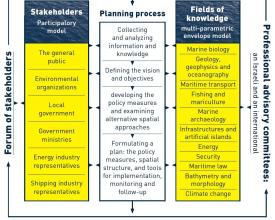
Good Practices for Climate Change Adaptation

Context
Challenges addressed
Location
Process
Summary of the process
Building Blocks
Strategic project alliance
Development of the best practices catalog was facilitated by a core team of experienced partners, each one with a distinct role and niche. A team charter details each partner’s role and responsibilities. The core partners were: The state environmental agency, which aims to reduce risks to coastal communities and the tourism industry. The agency was key to align partners’ interests but did not participate in the core team. A regional tourism initiative, which has worked for 10 years in the area to reduce tourism impacts on the environment. The initiative has developed catalogs of best practices, provided training and technical assistance, and serves on technical committees to review municipal land use zoning. The local architecture school trains both students and professionals, and works with municipalities to improve urban conditions, land use zoning and building codes. The school involved faculty and students from ocean management, biology, and engineering sectors, and provided faculty time and facilities. A global NGO partner developed tools to assess coastal climate change risks and to promote the use of natural defenses. The organization helped form alliances and partnerships, and provided funding to conduct the process.
Enabling factors
- The existence of partnerships with the right capacities that complemented each other needs and abilities.
- Availability of resources and funding.
- Alignment of interests and willingness to collaborate.
Lesson learned
People and entrepreneurs are willing to collaborate given the right conditions: transparency, an organized process and clear goals. A core team (3 partners) that leads and convenes a wide range of allies (professional associations, hotels, governments) is an efficient approach. The core team maintains the focus, eases communication and allows other stakeholders to participate.
Interest group engagement
The project core team approached two municipal governments, the regional hotel associations, almost 40 hotel owners and managers, technical institute faculty and architects, and engineers’ associations to assess their interests in participating in the project. Partners organized panels and meetings to present the project, its importance and forms of participation. This phase was critical to fully involve interest groups - not only to provide information, but more importantly, to increase their willingness to use the results. Stakeholders participated in the kick off process, provided information, reviewed results, revised each identified practice, and are currently involved in catalog dissemination.
Enabling factors
Several hurricanes hit the region in the last 13 years, making people aware of their vulnerability and the urgency to address climate change impacts and events. Members of the core team have a long and recognized experience in the state.
Lesson learned
Early involvement of stakeholders and interests groups is important to obtain buy-in in the process and acceptance of the results.
Experiences and practices documentation
A technical team developed the methodology and instruments to collect, organize and asses the information. It included guidance for data collectors, a format to download the information, forms to obtain authorization to publish the answers and pictures of the best practices. Technical institute students were trained in using and testing the data collection instruments. A local environmental NGO focused on the northern section of the State, where they interviewed managers of large tourism corporations and developments, based upon the NGO’s long-term relationship with the tourism industry. The technical institute focused on the southern section of the state and interviewed small-scale hotels and houses owners in coastal communities. The technical institute built a database with the information from both areas. The database was thoroughly revised by the technical team and then revised by local experts (architects, engineers, biologists, oceanographers) in workshops, via email and personal interviews organized by the three organizations.
Enabling factors
Experts were highly interested, and dedicated quality time to the revision, recognizing the importance of the catalog which resulted from their early involvement in the process. As an academic institution, the technical institute organized a group of dedicated students along with multidisciplinary faculty to conduct the survey and revisions in the southern area, while building capacities in the process.
Lesson learned
Devoting enough time to develop the instruments and testing them was crucial for successful data collection. The team did not have to go back to collect further information. Ensuring enough funding and time for all project phases is critical. Partners had time and staff for planning, developing instruments, building alliances, collecting data, integrating the information and for organizing expert reviews. These phases lasted 10 months. However, the final edition and design of the catalog along with appropriate and authorized pictures and diagrams lasted another 10 months - far more time than expected, due to lack of funding and available staff. The delay put at risk the acceptance of the product among stakeholders, whose enthusiasm will naturally fade away.








